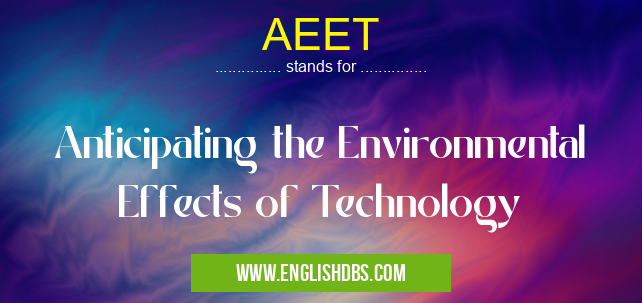What does AEET mean in TECHNOLOGY
AEET stands for Anticipating the Environmental Effects of Technology, a crucial concept in assessing and mitigating the potential environmental impacts of technological advancements.

AEET meaning in Technology in Computing
AEET mostly used in an acronym Technology in Category Computing that means Anticipating the Environmental Effects of Technology
Shorthand: AEET,
Full Form: Anticipating the Environmental Effects of Technology
For more information of "Anticipating the Environmental Effects of Technology", see the section below.
» Computing » Technology
Definition and Meaning
AEET involves predicting and evaluating the environmental consequences of new technologies before their widespread adoption. It considers the entire lifecycle of a technology, from its production, use, and disposal, to identify potential risks and benefits to the environment.
Importance of AEET
- Environmental Protection: AEET helps prevent or minimize environmental degradation by identifying potential risks associated with novel technologies.
- Sustainable Development: By anticipating environmental effects, AEET supports sustainable development practices, ensuring that technological advancements do not compromise environmental well-being.
- Informed Decision-Making: AEET provides decision-makers with evidence-based data to make informed choices about the adoption and use of new technologies.
- Corporate Responsibility: Companies can demonstrate environmental stewardship by actively engaging in AEET and mitigating the potential environmental impacts of their products and services.
Key Aspects of AEET
- Life Cycle Assessment: AEET considers the environmental impacts of a technology throughout its entire life cycle, including raw material extraction, manufacturing, use, and end-of-life disposal.
- Environmental Impact Assessment: AEET involves conducting environmental impact assessments to evaluate the potential effects of a technology on various environmental components (e.g., air, water, land, biodiversity).
- Mitigation Strategies: AEET identifies and recommends mitigation strategies to reduce or eliminate potential environmental risks associated with a technology.
- Stakeholder Engagement: AEET requires the involvement of stakeholders, including scientists, policymakers, industry representatives, and the public, to ensure a comprehensive assessment and informed decision-making.
Essential Questions and Answers on Anticipating the Environmental Effects of Technology in "COMPUTING»TECHNOLOGY"
What is AEET (Anticipating the Environmental Effects of Technology)?
AEET is a systematic approach to identifying and assessing the potential environmental impacts of new technologies before they are widely used. It involves considering the full lifecycle of a technology, from its development and production to its use and disposal, to minimize its environmental footprint.
Why is AEET important?
AEET helps decision-makers understand the environmental impacts of new technologies, allowing them to make informed choices about their development and deployment. By proactively identifying and mitigating potential risks, AEET can prevent or minimize environmental damage and promote sustainable innovation.
How is AEET conducted?
AEET typically involves multiple steps, including:
- Scoping: Defining the scope of the assessment and identifying the key environmental issues to be considered.
- Life cycle assessment: Analyzing the environmental impacts of the technology throughout its life cycle.
- Risk assessment: Identifying potential environmental hazards and evaluating their likelihood and severity.
- Mitigation planning: Developing strategies to minimize or eliminate identified risks.
Who is responsible for conducting AEET?
Responsibility for AEET typically lies with the developers, manufacturers, and users of new technologies. However, governments and regulatory agencies may also play a role in establishing standards and guidelines for AEET.
What are some examples of AEET in practice?
AEET has been used to assess a wide range of technologies, including:
- Nanotechnology: Evaluating the potential risks and benefits of nanomaterials.
- Genetically modified organisms (GMOs): Assessing their impact on biodiversity and human health.
- Renewable energy technologies: Identifying the environmental trade-offs associated with different options.
How can AEET contribute to sustainable development?
By integrating environmental considerations into technology development, AEET promotes sustainable innovation and helps ensure that new technologies contribute to a cleaner and healthier planet. It enables decision-makers to make informed choices about technologies that minimize environmental impacts and support long-term sustainability.
Final Words: AEET is an essential practice that enables decision-makers to anticipate and mitigate the environmental effects of technology. By promoting sustainable development and informed choices, AEET plays a critical role in safeguarding the environment and ensuring a future where technological advancements coexist harmoniously with the natural world.
AEET also stands for: |
|
| All stands for AEET |
